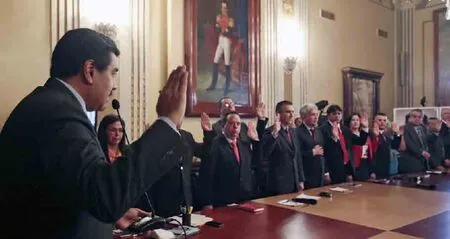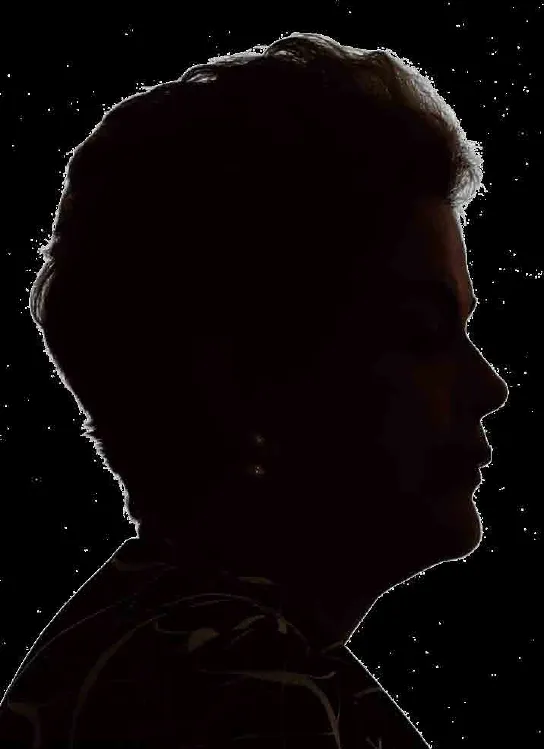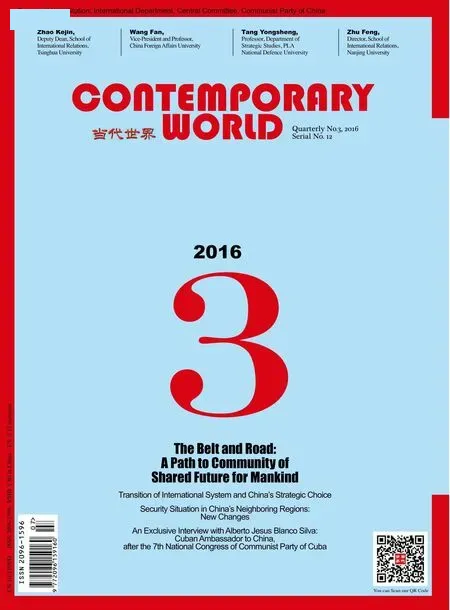Sharp Changes Took Place in Political Structure of Latin-American Countries: Causes, Impacts and Prospect
2016-09-20XUSHicHENGHonoraryAcademicianofCASSResearcherofCASSInstituteofLatinAmericanStudies
XU SHicHENGHonorary Academician of CASS, Researcher of CASS Institute of Latin American Studies
Sharp Changes Took Place in Political Structure of Latin-American Countries: Causes, Impacts and Prospect
XU SHicHENG
Honorary Academician of CASS, Researcher of CASS Institute of Latin American Studies
In recent years, sharp changes took place in the political structure of Latin-American countries. As a result, the Latin American politics showed a rightwards swing, the major manifestations of which include repeated failures in elections, intensified difficulties in ruling and prominent crisis in governance of the left-wing political parties; Overall economic descending brought about aggravated social tension, upsurging social antagonism and continuous public protests.
RiGHTWARDs SWiNG oF LATiN AMERicAN PoliTics
Following Chavez’s assuming the presidency by election on February 2,1999, the left-wing or center-left political parties in more than ten Latin American countries won general elections and came into power, which symbolized the collective rising of the left-wing forces with rapidly uplifting influence in Latin American countries. However, in recent 6 months, the Latin American left-wing governments have suffered successive setbacks. The following symbolizes the decline of the Latin American left-wing forces: Argentina’s right-wing force came into power. The right-wing electoral front Republican Proposal leader Macri was elected the new president with a very small margin in Argentina’s second-round presidential election held on November 22, 2015. President Macri’s inauguration on December 10 ended the 12-year ruling of the leftwing leader of the Justicialist Party Kirchner and his wife Cristina Fernández. After taking office, Macri has adopted a series of neo-liberal measures, such as liberalizing exchange rate, dismissing a large number of public servants, substantially raising the prices of household electricity, gas and public transportation, reaching reconciliation with the US “Vulture Fund” on repayment of the debt totaling 12 billion US$ with cash. Though having improved the environment for foreign investment, those measures have drawn constant protests for their impact on the livelihood of the middle-and-lower-class people.
In the parliamentary election held on December 6, 2015 in Venezuela, the right-wing opposition “Democratic Unity” coalition won over two thirds of the total seats, i.e. 112 seats out of 167,while the ruling United Socialist Party got only 55 seats. Since the oppositioncontrolled new parliament started to perform on January 5, 2016, the conflicts between the administrative and the legislative in Venezuela havebecome more and more violent. The parliament has passed quite a number of laws, including the amnesty law, the central bank reform law and the property right law among others,which however have been all rejected by the Supreme Court or the National Electoral Council under the control of the ruling Chavez faction.

On 6 January,2016,Venezuela's President Nicolas Maduro announced to adjust the cabinet members sharply in order to cope with the challenges in Venezuela.
The drop of the international oil price exerted serious impact on the economy of Venezuela, which caused sharp decline of the country’s foreign exchange income. Its economy has witnessed continuous negative growth: -4% in 2014, -7.1% in 2015 and -7% predicted for 2016. The inflation rate has been increasingly exacerbated: 72.8% in 2014, 141.5% in 2015 and 481% forecast for 2016. The currency has depreciated sharply, and the material supply shortage rate reaches as high as over 70%. Maduro proposed an economic emergency act to the parliament on January 14, which was turned down on the 22 of the same month. Yet the parliament rejection was invalid under the decision of the Supreme Court on February 17. On the same day, Maduro announced a number of new economic measures, including reforming the exchange rate system, raising gasoline price and uplifting the standard of lowest wage and retirement pension. Maduro also declared the Bolivar Economic Agenda 2016-2019, aiming at casting off the single economic model depending on oil and setting up a new production economic model. He also put forward 14 engines for developing new-type production economy, which focused on the development of agriculture, medicine and manufacture. However, these measures and plans encountered many difficulties in implementation and produced very little effect.
The Rousseff Administration of the Brazilian Workers’ Party underwent governance crisis. Since Rousseff’s re-election at the beginning of 2015,Brazil’s economy has suffered a continuous decline due to the low price of primary products in international market. The growth rate of 2015 was -3.7%, and the predicted figure for 2016 is almost the same. The inflation rate raised to nearly 10%, and employment rate was 9%. As a result of the economic recession, the government’s social expenditure decreased while the prices of commodities and services increased, which caused successive public protests. Rousseff’s support rate in the public opinion polls once dropped to 7%. A number of the Workers’ Party and government high officials have been involved in corruption cases, to which even former President Lula was charged implicated. Conflicts among the parties in Rousseff’s ruling coalition especially between the Workers’Party and one of the major alliances the Brazilian Democratic Movement Party (PMDB) have deepened. PMDB member and President of the Chamber of Deputies Cunha worked in collusion with PMDB President and the Brazilian Vice-President Temer in impeachment against President Rousseff. Later on March 29, 2016, PMDB announced its withdrawal from the coalition government led by Rousseff. On April 17, President Rousseff’s impeachment case was passed on the plenary meeting of the Chamber of Deputies by a vote of 367 (higher than 362, the two thirds of total) to 137, which officially kicked off the impeachment proceedings. On May 12, the Senate of Brazil passed the Impeachment Report by a vote of 55 to 22.
In Bolivia, a constitutional referendum was held on 21 February 2016 to decide whether President Morales would be allowed to run for a third consecutive term in 2019. The referendum was voted down by 51.3% to 48.7%, which symbolized Morales’ first failure in his ten-year rule.

The Constitutional Court of Ecuador adopted a resolution in November 2014 which approved a proposal for constitution amendment allowing President Correa to run for the second term in 2017. However, Correa made a decision to give up due to the worsened economic situation, the opposition protest and the successive setbacks of the left-wing forces in Latin America.
According to some commentators, the failures of the left-wing political parties in the elections of Argentina and Venezuela as well as the shaking of the ruling of Brazilian Workers’ Party are exerting negative impact on other left-wing regimes and political parties in Latin America. They even indicate that the Latin American left-wing regimes starting from 1999 are stepping from a high tide to a low one. Some Latin American people believe that the cycle of the progressive governments in Latin America has concluded.
CAUsEs FoR LoW TiDE oF LATiN AMERicAN LEFT-WiNG REGiMEs
There are deep causes from both inside and outside for the low tide of Latin American left-wing regimes. Firstly, from an economic perspective,bulk commodity price in international market dropped marginally in recently years due to global economic slowdown. As a result, Brazil, Venezuela and other Latin American countries depending on primary products export all witnessed a slowdown of economic growth and freeze-up of the prosperity cycle of export economy. According to the most recent data issued by the UN Economic Commission for Latin America and the Caribbean, the economic growth rate in Latin America was only 1.2% in 2014 and -0.4% in 2015. The predicted figure for 2016 is -0.6%,even lower than that of 2015. Under the pressure of economic recession, in order to maintain the macroeconomic stability, the Latin American left-wing governments had to adopt a series of tightening measures to cut down public and social expenditures. That has somewhat exerted negative impact on the implementation of some social programs. Some middle-class people who used to be poverty-stricken are faced with risks of returning to poverty. Thus, there are always public protests in Latin American countries. The left-wing governments in Latin America failed to take the advantages of the favorable economic policies in previous years to make timely adjustment on the unitary economic structure and policies. Moreover, the extreme economic policies have also dampened the enthusiasm of private business owners.
Secondly, in terms of political systems, a left-wing government in Latin America usually consists of several political parties with different political views. In addition, being faction riven, disorganized and backward in ideology, the major ruling party lacks capacity for leading, organizing and social mobilization. With tensions and contradictions inside, it is impossiblefor the left-wing governments to be united and form joint efforts.
Thirdly, most of the left-wing political parties won elections by holding high the banner of anti-corruption. However, coming into power, with changed social position and incapable supervision within the party, some left-wing political parties and governments started to corrupt. Anti-corruption often serves as the flashpoint for public protests. That together with the worsening economic situation has caused constant public protests.
Fourthly, the US has been interfered the domestic affairs of the left-wing Latin American countries through various channels. The US National Endowment for Democracy, the UNDP among other agencies and the diplomats in the US embassies have been providing assistance to the opposition parties, NGOs and individuals in Venezuela, Brazil, Ecuador, Bolivia and other Latin American countries. They were instigated to launch economic and propaganda battles and to carry out various protestant activities and color revolutions aimed at overturning the left-wing governments. The US also adopts a policy of dividing and disintegrating the left-wing Latin American governments. For example,while restoring and improving its relationship with Cuba, the US has intensified its sanction and crack-down on Venezuela.
Fifthly, with support of the US and western right-wing political parties and personages, the right-wing conservative forces in Latin America have launched frequent crack-down on the left-wing governments and political parties in their own countries. At present, the right-wing forces are rising in Venezuela, Brazil and other Latin American countries ruled by left-wing regimes. The right-wing political parties in Ecuador and Bolivia are controlling the important cities and states(provinces). Meanwhile, in some countries ruled by left-wing parties, the major media have been always controlled by right-wing syndicates and are seriously rightist.
LEFT-WiNG PoliTicAl PARTiEs STill EXisT
For the above causes, Latin American left-wing political parties encountered widespread setback and started to step into a low tide. It is very probable that Latin American political field will continue to swing to the middle right in some time in the future. On 22 March 2016, during his academic visit to the US, Mexican former Foreign Minister Jorge Castaneda published an article entitled Death of Latin American Left Wing on New York Times. However, I do not agree to the view point in this article. Indeed, Latin American leftwing parties are in their low tides, yet they are far from being dead, or even“at the gate of death”. In December 2015, When attending the first meeting of the Political Parties’ Forum China-CELAC in Beijing, the then Minister of Culture of Ecuador (the current Minister of Foreign Affairs) told the correspondent of La Agencia EFE,S.A. : “The progressive political process in Latin America is undergoing a period of being weakened. However, that does not mean the end of Latin American left-wing governments.”
Let us look at Cuba first. On the 7th National Congress of the Communist Party of Cuba convened in April 2016,Raul Castro declared robustly that Cuba will stick to Socialism and the Communist leadership instead of restoring capitalism. The revolutionary leader of Cuba Fidel Castro also made an enlightening announcement at the closing ceremony of the same Congress: “The Communist Ideal of Cuba will exist on this planet as evidence.”We should see that apart from in Cuba,the left-wing parties are still ruling in quite a number of Latin American countries including Venezuela, Bolivia,Ecuador, Nicaragua, Chili, Uruguay and Salvador. President Rousseff of Brazil has not impeached yet. Maduro remains the President in power of Venezuela. Even in Argentina, the left wing still maintains considerable power, with the Justicialist Party being the majority in both the Senate and the Chamber of Deputies as well as ruling in nearly half of the total provinces and many cities. The left-wing forces should not be underestimated even in countries like Mexico, Columbia and Peru that are not ruled by leftwing parties. The left-wing Democratic Revolutionary Party ranks the third biggest party in Mexico. In Peru’s firstround general election held on April 10, the left-wing Broad Front candidate Verónika Mendoza ranked the third with 18.84% of the vote.
With huge gap between rich and poor as well as the sharp social contradictions in Latin America, the left-wing forces still have strong power and solid social foundation. Therefore, an overall incline to the right would not emerge in Latin American political map. During their ruling in the past decade, the left-wing political parties and governments have made remarkable and recognized achievements in combating neo-liberalism, developing national economy, poverty reduction, providing free education and medical service,adopting independent foreign policies and promoting the integration of Latin American countries. Therefore, the left-wing political parties and governments have won broad public support,especially from the middle-and-lowerclass people. The ruling achievements and experience of Latin American left-wing governments should not be totally repudiated only because of the difficulties and problems they are facing with. Although faced with various problems, Latin American left-wing political parties and governments will still have bright future so long as they tackle the serious challenges with a positive attitude. It is possible that Latin American politics will return to middle-left after policy readjustment for a period of time. Just as the Uruguay left-wing former President Mujica said: “I never believe that the left wing has already failed, neither do I believe that the right wing has already achieved absolute victory. The history of the mankind is a continuous struggle between conservatives and progressives, just like a pendulum.” “If the left wing loses its territory, then just draw the lesson and stage a comeback.”
杂志排行
Contemporary World的其它文章
- Distorting History Is Not Tolerable: An Interview with Soga Yuji, President of Japan-China Friendship Association for the 21st Century
- An Exclusive Interview with Alberto Jesus Blanco Silva: Cuban Ambassador to China, after the 7th National Congress of Communist Party of Cuba
- Analysis of the Rise of Spain’s“We Can” Party
- Prospects of Solution to Syrian Crisis
- Adjustment of EU Neighborhood Policy: From Value-Driven to Interest-Oriented
- “Thucydides Trap” and China-US Relations
